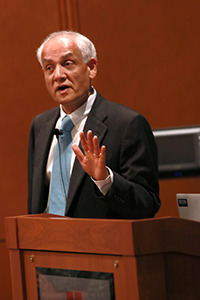
These aren’t subplots to a cautionary science fiction film. They are the predictions based on well-documented research, and it will require the minds of this country’s top scientists to tackle this astonishing growth, said Pramod Khargonekar, assistant director of the Directorate of Engineering for the National Science Foundation.
Khargonekar was this year’s guest lecturer for the 2015 William R. and Erlyn J. Gould Distinguished Lecture on Technology and the Quality of Life. The event was held Tuesday, Nov. 10, at the J. Willard Marriott Library on the University of Utah campus. Video of the entire lecture can be viewed here.
His presentation, “Engineering for the 21st Century — A Perspective from the National Science Foundation,” touched on the explosive growth in both the world’s population and in technology in the last 200 years, including the evolution of electricity, the mechanization of agricultural labor and the impact of the automobile.
But for the next 50 years or so, that growth will continue to skyrocket, he said. By 2050, 9.6 billion people will inhabit the Earth, and the global middle class as well as the older population will continue to grow. Meanwhile, more people will consume energy, and climate change will continue to have an adverse effect on the planet.
“Almost every part of the world will be impacted,” he said.
Consequently, he added, some of the biggest problems that could develop in the next 50 years likely will involve energy, water, food, the environment and poverty, among others. But he also said that technologies such as mobile devices, cloud-based services, advanced robotics, autonomous vehicles and 3-D printing could help drive solutions to those problems.
The National Science Foundation (NSF), the U.S. government agency that funds research and education in fields of science and engineering, has requested a $7.7 billion budget for fiscal year 2016 to invest in more research, education and innovation, Khargonekar said.
He said there are six technological trends to focus on: ubiquitous computing and communications, systems science and engineering, nanoscale science and technologies, biomedical/medical technologies, behavioral/economic/cognitive sciences, and the art of design and aesthetics. The agency has been funding projects in clean energy technology, cyber-physical systems, resilient infrastructure systems and processes, and in smart communications. He added that the agency also is investing more in broadening the diversity of students in engineering.
Khargonekar received his bachelor’s in electrical engineering from the Indian Institute of Technology in India and a master’s in mathematics and a Ph.D. in electrical engineering from the University of Florida. He has held faculty positions at the University of Florida, University of Minnesota and the University of Michigan. His research is focused on theory and applications of systems and controls.